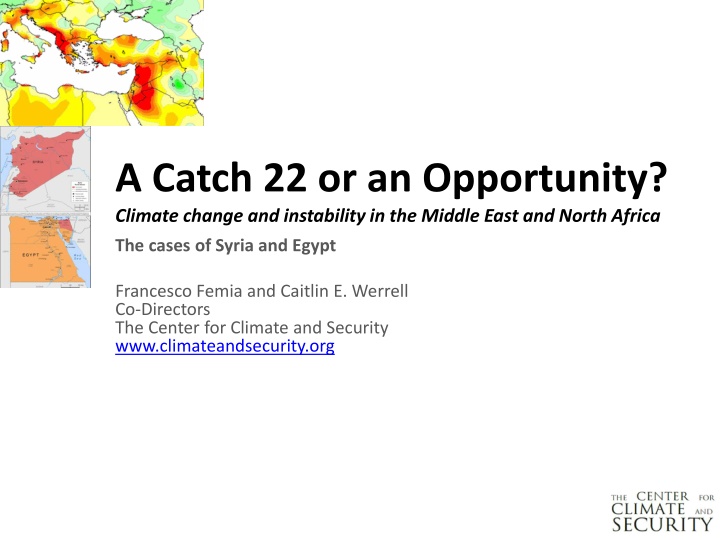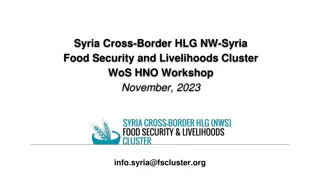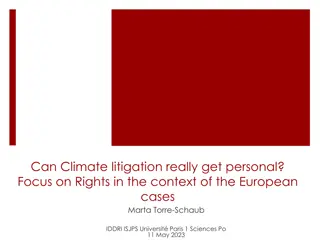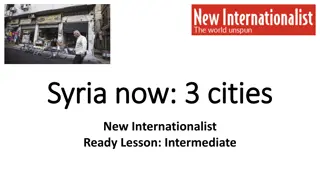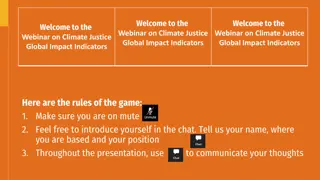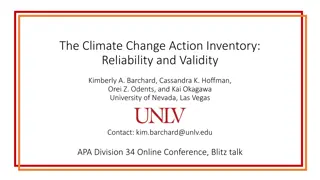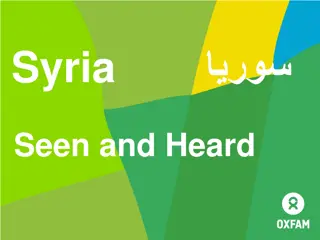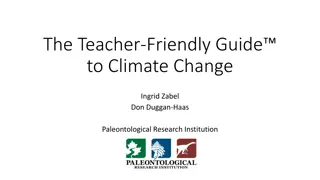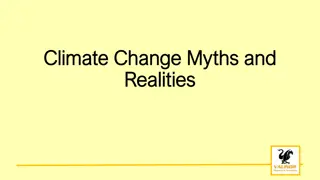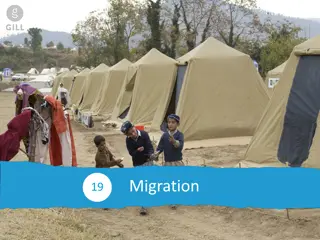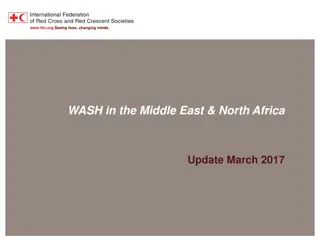Climate Change Impact on Middle East: Syria and Egypt Cases
Climate change has led to devastating consequences in the Middle East, with Syria experiencing severe droughts from 2007-2010, resulting in crop failures, livestock loss, and widespread displacement. The region's vulnerability to water scarcity and food insecurity highlights the urgent need for climate adaptation and security measures to prevent further instability and social unrest.
Download Presentation

Please find below an Image/Link to download the presentation.
The content on the website is provided AS IS for your information and personal use only. It may not be sold, licensed, or shared on other websites without obtaining consent from the author.If you encounter any issues during the download, it is possible that the publisher has removed the file from their server.
You are allowed to download the files provided on this website for personal or commercial use, subject to the condition that they are used lawfully. All files are the property of their respective owners.
The content on the website is provided AS IS for your information and personal use only. It may not be sold, licensed, or shared on other websites without obtaining consent from the author.
E N D
Presentation Transcript
A Catch 22 or an Opportunity? Climate change and instability in the Middle East and North Africa The cases of Syria and Egypt Francesco Femia and Caitlin E. Werrell Co-Directors The Center for Climate and Security www.climateandsecurity.org
Climate-Water-Food Nexus Climate Change manifests itself primarily through water and food Admiral Titley, USN (ret): It s all about the water Variability Too much Too little Wrong place, wrong time Wet where it was dry Dry where it was wet Drier where it was dry Salty where it was fresh Change in chemistry And the food: Increased water insecurity due to climate variability, both globally and in the Middle East and North Africa (MENA), has a significant effect on food security in the region
Syria: Drought 2007-2010: Worst drought in Syria s history of records 2011 Global Assessment Report on Disaster Risk Reduction (GAR): Farmers: Of those most vulnerable, 75% suffer total crop failure Herders in northeast: Lose 85% of their livestock, affecting 1.3 million people Standard Precipitation Index (SPI) (-1 = moderate drought; -2 = extreme drought). Drought, Five-year Scale, Syria from 2006 to 2012 Source: Werrell, Femia and Sternberg, Did We See it Coming? State Fragility, Climate Vulnerability, and the Uprisings in Syria and Egypt, SAIS Review of International Affairs, Volume 35, Number 1, Winter-Spring 2015, pp. 29-46 Source: W. Erian et al., Drought Vulnerability in the Arab Region Special Case Study: Syria (Geneva: United Nations International Strategy for Disaster Reduction, 2010), pp11.
Livelihoods decimated 2009 UN and IFRC: 800,000 Syrians lost entire livelihood as a result of the droughts 2010 UN: 2-3 million driven into extreme poverty 2011 GAR: 1 million Syrians left extremely food insecure by droughts Source: F. Femia and C. Werrell, 2012. Syria: Climate Change, Drought and Social Unrest , The Center for Climate and Security, 29 Feb. 2012.
Internal displacement October 2010: UN estimates 50,000 families migrated from rural areas just that year, on top of the hundreds of thousands of people who fled in earlier years. January 2011: crop failures just in farming villages around Aleppo lead 200,000 rural villagers to leave for the cities. Total 2007-2011: 1.3 1.5 million people displaced, most move to urban areas. Source: F. Femia and C. Werrell, 2012. Syria: Climate Change, Drought and Social Unrest , The Center for Climate and Security, 29 Feb. 2012.
Climate change 2011 NOAA: High likelihood winter drying from 1971-2010 in Mediterranean littoral and Middle East linked to climate change. Syria one of driest. 2015 Kelley et al: 2007-2010 drought 2-3x more likely due to climate change IFPRI climate model: If current rates of global greenhouse gas emissions continue, yields of rainfed crops in Syria may decline between 29 and 57 percent from 2010 to 2050. Sources: M. Hoerling et al., On the Increased Frequency of Mediterranean Drought, Journal of Climate 25 (2012), pp.2146 61. Reds and oranges highlight lands around the Mediterranean that experienced significantly drier winters during 1971-2010 than the comparison period of 1902- 2010 Kelley, Colin et al, 2015. Climate change in the Fertile Crescent and implications of the recent Syrian drought. Proceedings of the National Academy of Sciences (Impact Factor: 9.81). 03/2015; 112(11) C. Breisinger et al, 2010. Food Security and Economic Development in the Middle East and North Africa: Discussion Paper 00985, International Food Policy Research Institute. Source: M. Hoerling et al., On the Increased Frequency of Mediterranean Drought, Journal of Climate 25 (2012), pp.2146 61.
Climate change Winter precipitation trends in the Mediterranean region for the period 1902 2010 (Hoerling et al. 2011).
Natural resource mismanagement Heavily-subsidized water-intensive wheat and cotton farming Encouragement of inefficient irrigation techniques: e.g. flood irrigation 60% of water used is wasted Over-pumping of groundwater: Syria s National Agricultural Policy Center: increase in wells tapping aquifers from just over 135,000 in 1999 to more than 213,000 in 2007 caused groundwater levels to plummet in many parts of the country... 2007: Syria consumed 19.2 billion cubic metres of water - 3.5 billion more than the amount of water replenished naturally Some evidence of well-drilling contracts awarded on sectarian basis Source: F. Femia and C. Werrell, 2012. Syria: Climate Change, Drought and Social Unrest , The Center for Climate and Security, 29 Feb. 2012.
Demographics & desertification Over-grazing of land Rapidly growing population Rising demand for meat from growing and increasingly affluent population Contributes to land degradation and water insecurity Source: F. de Ch tel, 2014. The Role of Drought and Climate Change in the Syrian Uprising: Untangling the Triggers of the Revolution. Middle Eastern Studies. Vol. 50, Iss. 4, 2014, pp. 3)
Pressure on urban areas Context: Syrian cities coping with influxes of Iraqi refugees since 2003, steady influx of Palestinian refugees, and from 2007-2011, around 1.5 million Syrian farmers and herders Citiesalready experiencing serious water infrastructure deficiencies e.g. Damascus water network leaks up to 60 percent of the water it carries, according to local authorities 2007-2011: Francesca de Ch tel: Syria experienced a huge deterioration of [water] availability per capita, partly as a result of a crumbling urban infrastructure. Source: F. Femia and C. Werrell, 2012. Syria: Climate Change, Drought and Social Unrest , The Center for Climate and Security, 29 Feb. 2012.
Rural communities & unrest Role of disaffected rural communities in early Syrian opposition movement prominent compared to equivalents in other Arab uprising countries. 2011: Rural farming town of Dara a focal point for protests in early stages of the opposition movement a place especially hard hit by five years of drought and water scarcity Source: F. Femia and C. Werrell, 2012. Syria: Climate Change, Drought and Social Unrest , The Center for Climate and Security, 29 Feb. 2012.
Egypt Produces little of its own food/ essential staples (bread) Per Capita Top Wheat Importing Countries, Percent Income Spent on Food and Average Age Depends on stability of global wheat market Net grain importer (one of 8 of 10 MENA nations most dependent on global wheat market) Bread subsidies insufficient to control price Source: ERS, Food CPI and Expenditures Briefing Room, Table 97, 2011. Cited in: Troy Sternberg, Chinese drought, bread and the Arab Spring, Applied Geography 34 (2012): 519 524.
Drought in China and Russia (-1=drought; -2=extreme drought) 2010 drought in China 2010 heat wave in Russia (more likely due to climate change)* Wheat harvests devastated China and Russia purchase significant amount of wheat on global market Global wheat prices spike Egypt affected *Sources: Drought at One- to-Three-Month Timescales November 2010 through January 2011. Standard Precipitation Index (SPI). Stefan Rahmstorf and Dim Coumou, Increase of Extreme Events in a Warming World, Proceedings of the National Academy of Sciences of the United States of America 108, no. 44 (November 2011): 17905 17909. Source: Werrell, Femia and Sternberg, Did We See it Coming? State Fragility, Climate Vulnerability, and the Uprisings in Syria and Egypt, SAIS Review of International Affairs, Volume 35, Number 1, Winter- Spring 2015, pp. 29-46 Friederike E. L. Otto et al., Reconciling Two Approaches to Attribution of the 2010 Russian Heat Wave, Geophysical Research Letters 39, no. 4 (February 2012).
Rural bread riots coincide with Tahrir square Bread prices rise 300% in Egypt Bread subsidies regime corrupt, does not affect price of bread in rural areas At least three major reported bread riots in 2011 May have broadened appeal of uprising beyond urban areas Sources: Werrell, Femia and Sternberg, Did We See it Coming? State Fragility, Climate Vulnerability, and the Uprisings in Syria and Egypt, SAIS Review of International Affairs, Volume 35, Number 1, Winter-Spring 2015, pp. 29-46 Marco Lagi et al., The Food Crises and Political Instability in North Africa and the Middle East, New England Complex Systems Institute, August 10, 2011.
Syria and Egypt: Environmental Security Drivers Environmental security variables and attendant impacts generally missing from analysis of Syria and Egypt fragility Complexity Outdated predictive tools and indices? Source: Werrell, Femia and Sternberg, Did We See it Coming? State Fragility, Climate Vulnerability, and the Uprisings in Syria and Egypt, SAIS Review of International Affairs, Volume 35, Number 1, Winter-Spring 2015, pp. 29-46
Syria: Immune to the Arab uprisings? Many political & intelligence analysts predict Syria is immune to drivers that precipitated the Arab uprisings in Tunisia, Egypt, Libya Obama administration: Developed list of nations likely to be at risk of large-scale political turmoil: Syria at bottom of list. No one was focused on Syria, because it seemed far less likely than other states in the region U.S. Deputy Secretary of State James Steinberg Source: J.Mann. 2012. The Obamians: The Struggle Inside the White House to Redefine American Power , pg 270, Viking Press.
Catch-22 Self-sufficient, or dependent on global food market, countries are vulnerable to climate risks. Syria by 2050: Rainfed crops decrease up to 57% Nile Delta: 30-40% Egypt s agriculture production 30% Egypt labor force agrarian Alexandria Egypt 0.5 meter rise seas would displace 2 mil people. Sources: Alexandria, Egypt F. Femia and C. Werrell, 2012. Syria: Climate Change, Drought and Social Unrest , The Center for Climate and Security, 29 Feb. 2012. F. Femia and C. Werrell, 2011, Egypt s Political Transition and the Rising Sea: An Opportunity for Reform , The Center for Climate and Security, 16 Jan. 2012
Or opportunity Solutions could be leveraged for conflict-resolution Historical precedent of cooperation between conflicting parties over scarce water resources, in particular* Resources devoted to climate adaptation in the region must become a higher development and security priority Climate adaptation should become a new form of development and security assistance Alternatives to water-intensive crop production, and flood irrigation *Source: Wolf, A. T. "International Water Conflict Resolution: Lessons from Comparative Analysis." International Journal of Water Resources Development. Vol. 13 #3, December 1997.
Lessons for analysis Environmental/ natural resource security variables are unexplored potential drivers of unrest in Syria and Egypt More research needed to disentangle lines of causality Environmental security/ natural resource variables need better integration into indices and predictive tools on state fragility, conflict, global risks, etc. Source: World Economic Forom, Global Risks Report 2014 Source: Werrell, Femia and Sternberg, Did We See it Coming? State Fragility, Climate Vulnerability, and the Uprisings in Syria and Egypt, SAIS Review of International Affairs, Volume 35, Number 1, Winter-Spring 2015, pp. 29-46
Questions? Francesco Femia: ffemia@climateandsecurity.org The Center for Climate and Security: www.climateandsecurity.org Climate and Security 101: www.climatesecurity101.org F. Femia and C. Werrell, 2012. Syria: Climate Change, Drought and Social Unrest , The Center for Climate and Security, 29 Feb. 2012. Werrell, Femia and Sternberg, Did We See it Coming? State Fragility, Climate Vulnerability, and the Uprisings in Syria and Egypt, SAIS Review of International Affairs, Volume 35, Number 1, Winter-Spring 2015, pp. 29-46
